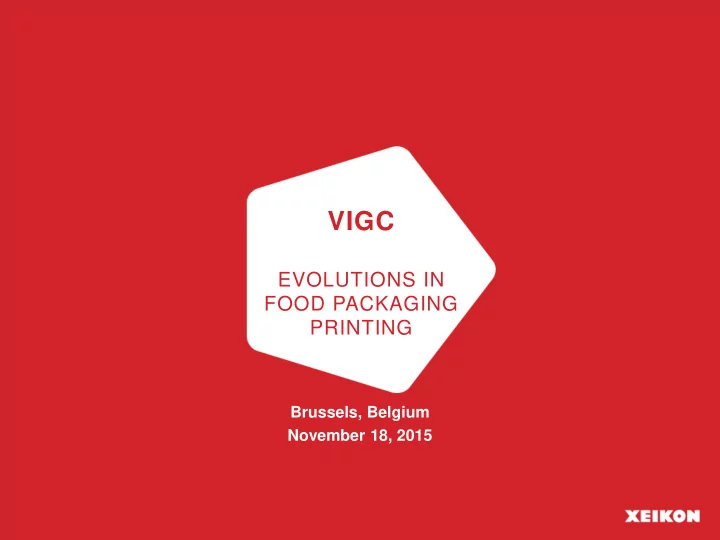

VIGC EVOLUTIONS IN FOOD PACKAGING PRINTING Brussels, Belgium November 18, 2015
LOW MIGRATION OR NO MIGRATION? THE 1000 DALTON RULE Dr. Johan De Houwer Regulatory affairs, patents and grants officer
OVERVIEW Introduction Electrophotography – Xeikon process National and international legislation Migration - 1000 Dalton rule Traceability Why go digital?
INTRODUCTION Xeikon sites Lier, BE Xeikon Digital solutions Heultje, BE Xeikon Toner Manufacturing Ypres, BE Prepress solutions
INTRODUCTION Xeikon’s digital revenue split per segment Document & Commercial Labels & Packaging 23% 33% 41% 45% 51% 58% 77% 67% 59% 55% 49% 42% 2010 2011 2012 2013 2014 2015
INTRODUCTION Why is Xeikon growing in the L&P segment ? Dedicated toners since 2010: QA-I toner QA-IC (ICE) toner QA-CH (Cheetah) toner Dedicated digital presses Image quality (1200 dpi 4 bit) Substrate versatility
INTRODUCTION Xeikon CX3 fastest digital label press 30 m/min Xeikon 3000 series 5 different presses
INTRODUCTION What will the future bring? FUSION technology High end labels and packaging One pass One platform All digital
ELECTROPHOTOGRAPHY 1. Charging of the OPC 2. Writing of the latent image 3. Development 4. Transfer to the substrate 5. Charge erasing 6. Pre charging 7. Cleaning
XEIKON PROCESS Full rotary printing - variable repeat 1200 dpi 4 bit print quality Variable web widths Printing speed is not affected by label or repeat size # colors used Perfect repeat imposition Very accurate Color to Color registration 2 pt text 600 dpi 1200 dpi
LEGISLATION German Ordinance on Swiss Ordinance on printing inks printing inks Nestlé Guidelines Plastics regulation (PIM) EU 10/2011 Food contact materials Framework regulation FDA regulation EC 1935/2004 (US legislation) Good manufacturing practice (GMP) EC 2023/2006
LEGISLATION General requirements (Framework regulation): General requirements (Framework regulation): “Materials and articles, including active and intelligent materials “Materials and articles, including active and intelligent materials and articles, shall be manufactured in compliance with good and articles, shall be manufactured in compliance with good manufacturing practice so that, under normal or foreseeable manufacturing practice so that, under normal or foreseeable conditions of use, they do not transfer their constituents to conditions of use, they do not transfer their constituents to food in quantities which could: food in quantities which could: endanger human health; endanger human health; bring about an unacceptable change in the composition of bring about an unacceptable change in the composition of the food; the food; bring about a deterioration in the organoleptic bring about a deterioration in the organoleptic characteristics thereof.” characteristics thereof.”
MIGRATION ‘migration’ means a partition and diffusion controlled transfer process of small molecules from the food contact material or article into food or food simulant 3 types of migration through the substrate set-off to the reverse side (e.g. by rewinding or stacking) gas phase transfer (VOC) ‘overall’ vs ‘specific’ migration limit
MIGRATION ‘overall migration’ means the sum of the amount of volatile and non volatile substances released from a material or article into food or food simulant. The Overall Migration Limit (OML) means the maximum permitted amount. ‘specific migration’ means the amount of a specific substance released from a material or article into food or food simulant. The Specific Migration Limit (SML) means the maximum permitted amount.
MIGRATION The overall migration limit according to the PIM regulation is set at 60 ppm (parts per million) for a cubic package with a surface area of 6 dm² This relates to 60 mg of migrant per 1 kg of food (simulant), or 10 mg per 1 dm² of surface area in contact with the food (simulant) The limit of no concern (limit of no migration) is set at 10 ppb (parts per billion) The specific migration limit lies in between these two values
MIGRATION lacker/coating ‘functional barrier’ ‘functional barrier’ means a barrier consisting of one or more functional barrier layers which shall ensure that the migration of authorized substances does not exceed the overall migration limit or their specific migration limit, and which prevent the transfer of non- evaluated substances above a threshold level of no concern (non-detectability) food substrate printing ink or toner
MIGRATION ‘So it’s not only our toner ?’ RIGHT !! Combination of all parts of the package: Substrate Lacquer or laminate Coatings Decoration Storage conditions Preparation conditions
MIGRATION Migration (mobility) depends on: Migration (mobility) depends on: size of the molecule (the larger, the lower the mobility) size of the molecule (the larger, the lower the mobility) temperature (± 1000x higher mobility at 100 °C vs 25 °C) temperature (± 1000x higher mobility at 100 °C vs 25 °C) time (related to shelf life) time (related to shelf life) nature of the food (dry/wet, fatty, dairy, …) nature of the food (dry/wet, fatty, dairy, …) type of substrate (PE/PP different from PET, metallics, …) type of substrate (PE/PP different from PET, metallics, …) type of coating (shielding ability?!) type of coating (shielding ability?!)
‘1000 DALTON RULE’ Molecules weighing more than 1000 Dalton (g/mol) are not considered to migrate In practice this means > 70 carbon atoms on average Typical examples of ‘heavy’ molecules: Synthetic Polymers Biopolymers Proteins Polysaccharides
XEIKON TONER General composition of toner: > 90% polyester (transparent polymer) pigments additives (fillers, charging agents, …) Average size of the toner particles is 7-8 micron
XEIKON TONER Dedicated toners for labels and packaging Different melting temperatures, depending on the application QA-I vs ICE and CHEETAH toner Several food approvals and other certificates: ISEGA FDA Deinkability Swiss List/Nestlé Eco regulatory.affairs@xeikon.com
TRACEABILITY Traceablity of the packaging material Xeikon QR code on labels Traceable to: Batch Ingredients Process parameters Which toner at which customer
TRACEABILITY
WHY GO DIGITAL Complementary technology to conventional printing More economically viable for short and medium runs Value-added printing Variable data Security aspects to prevent counterfeiting Just in time business concept More automated workflow Quick variations in design (christmas, halloween, …)
CLOSING REMARKS National and international legislation Dedicated (low migration) toners for L&P market Dedicated suites (self adhesive & heat transfer labels, folding carton, …) Food certification Traceability Sustainability
QUESTIONS?
Recommend
More recommend